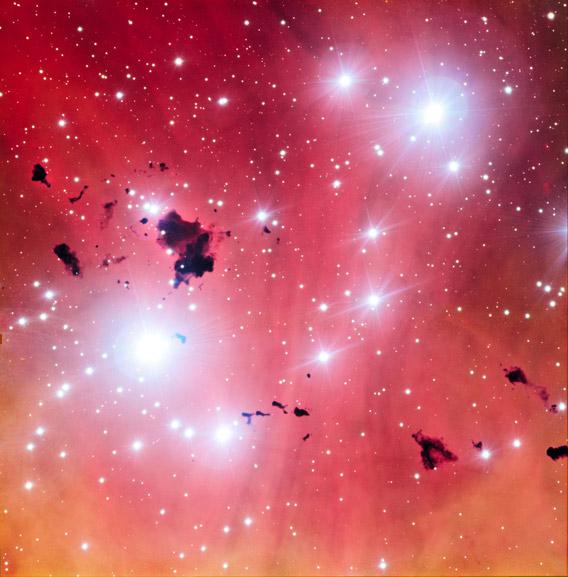On May 25, 1998, the first of the four telescopes that would collectively be called the Very Large Telescope (or VLT) opened its eight-meter eye on the sky. Over the next fifteen years, their combined might would scan the heavens, providing incredible views of celestial objects.
To celebrate its 15th anniversary, the European Southern Observatory released this lovely picture of the Lambda Centaurus nebula, also called IC 2944. It’s a huge nebula, a gas cloud, located roughly 6000 light years away (the star after which it’s named is actually only about 200 light years from Earth, so their proximity in the sky is a coincidence).
Stars are forming inside the cloud, and some of them are very massive and hot. These stars blast out fierce ultraviolet radiation that heats and excites the hydrogen in the cloud. The gas responds by glowing in the red part of the spectrum—that’s the pink backdrop you see here, the color shifted a bit due to the way the picture combines light from different filters.

Photo by ESO
It’s common in nebulae like this to have thicker clumps of cooler molecular gas (predominantly molecules of hydrogen—H2—with a dash of things like carbon monoxide and other simple molecules). Cold and dense, they block the light coming from behind them, so we see them in silhouette. In the case of IC 2944 these are called Thackeray’s Globules, after A. David Thackeray, who first saw them.

Photo by NASA, ESA, STScI, J. Hester and P. Scowen (Arizona State University)
Interestingly, the big clump in the picture is actually two separate clouds, superposed from our position. Each is about a light year across (10 trillion kilometers, or 6 trillion miles), and probably combined have a mass about 15 times that of the Sun. They may have once all been part of a single structure, a long thick tower like the “Pillars of Creation” made famous by Hubble. Over time, that giant structure in IC 2944 was destroyed by the intense UV light and stellar winds of the young massive stars around it. All that’s left now are these small clumps.
Sometimes these globules are the locations of star formation as well. However, in this case, they won’t get a chance. The processes that destroyed the pillar are still at work, slowly eating them away from the outside in. Eventually, they’ll evaporate totally. Poof. Gone.
Such is life. But that’s just a reminder that we should celebrate the things we care about while we can. So in that vein: Happy 15th Birthday, VLT! May you have many more, and may you bring us more gifts like this.
